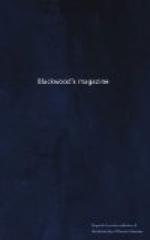“It was late, and I looked forth on the tranquil scene from my window. The moonbeams played upon the distant hilltops, but the lower masses slept as yet in shadow; again the pale light caught the waters of the Tweed, the lapse of whose streams fell faintly on the ear, like the murmuring of a sea-shell. In front rose up the mouldering abbey, deep in shadow; its pinnacles, and buttresses, and light tracery, but dimly seen in the solemn mass. A faint light twinkled for a space among the tomb-stones, soon it was extinct, and two figures passed off in the shadow, who had been digging a grave even at that late hour. As the night advanced, a change began to take place. Clouds heaved up over the horizon; the wind was heard in murmurs; the rack hurried athwart the moon; and utter darkness fell upon river, mountain, and haugh. Then the gust swelled louder, and the storm struck fierce and sudden against the casement. But as the morrow dawned, though rain-drops still hung upon the leaf, the clouds sailed away, the sun broke forth, and all was fair and tranquil.”—P. 97.
The fisherman was sent for express, and his general garb and fly-bedizened hat, are soon portrayed; while the “waxing” of the Tweed, and how the Eildon Hills were of old cloven by the art of grammarye, conclude the fourth chapter, and bring us only to the hundredth page.
The ensuing section of the work opens with some general observations on the scenery of that now noted district of the south of Scotland, blended with the graceful expression of those melancholy remembrances, we doubt not deeply felt, which must ever cast a dark shadow over the minds of the surviving associates of the Great Minstrel. Alas! where can we turn ourselves without being reminded of the transitory nature of this our low estate, of its dissevered ties, its buried hopes, and lost affections! How many bitter endurances, reflected from the bosom of the past, are ever mingling with all those ongoings of human life and action which we call enjoyments! How mixed in their effects are even the natural glories of this our fair creation! What golden sunset casts not its far-beaming splendour, not only on the great mountains and the glittering sea, but also breaks, as if in mockery, into ghastly chambers where the desolation of death, “the wages of sin,” is miserably brooding! And yet how solemnizing, how elevating in their influences, are all the highest beauties both of art and nature, notwithstanding the awe, approaching to fearfulness, with which they not seldom affect our spirits. The veneration with which we gaze even on insensate walls which once formed the loved abode of genius and virtue, is a natural tribute to a noble nature, and flows from one of the purest and most sustaining sources of emotion by which our humanity is distinguished. It almost looks as if, in accordance with the Platonic philosophy, there remained to man, from an original and more lofty state of existence, some dim remembrance of perfection.




